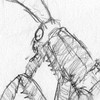HOME | DD
 artbyjrc — Lounging - Iguanians
artbyjrc — Lounging - Iguanians

#agama #anole #cretaceous #extinct #holocene #iguana #lizard #miocene #reptile #eocene #squamate #xianglong #iguania #leiocephalus #barbaturex #priscagama #anchaurosaurus #armandisaurus #pristiguana #chameleon
Published: 2022-10-14 09:06:00 +0000 UTC; Views: 16731; Favourites: 197; Downloads: 48
Redirect to original
Description
A selection of extinct members of the squamate lizards known as iguanomorphs, to scale.
Lizards are a successful group with over 7000 species (technically one should include snakes within the combined Squamata, as they are the ultimate 'legless lizards'; see Use it or lose it - Legless Lizards ). What makes them successful is a generalised bodyshape which has been morphed into a wide variety of shapes, sizes and niches. The smallest species (Sphaerodactylus geckoes and Brookesia chamaeleons) are just several centimetres long (see Tiddlers - the smallest vertebrates ) while the largest extinct species were the Cretaceous mosasaurs (see Giant sea lizards 1 - Mosasaurine Mosasaurs and Giant sea lizards 2 - Russellosaurine mosasaurs ), currently thought to have reached up to 13 metres in length. Mosasaurs were also the most aquatically-adapted lizards. Others have taken to the air (see Up in the air - Gliding reptiles ) while burrowing is very prevalent throughout many families. Iguanians are a major division of squamate lizards including some of the most diverse forms.
Some of the most familiar living lizards are iguanians, including agamas, iguanas, basilisks, chamaeleons and anoles. Two major groups are accepted, based largely on distribution and where the teeth were attached to the jawline - the Old World Acrodonta (chamaeleons, agamas) and mostly New World Pleurodonta (iguanas etc). Although a lack of commonality of morphological features makes grouping the two clades problematic, molecular analyses has shown the iguanamorphs to be monophyletic. The earliest possible iguanians date from the Mid Jurassic.
Acrodontans (fossil and living) are almost exclusively found in the Old World (Africa, Madagascar, Europe, Asia, and Australasia), apart from one basal form (Gueragama) from Late Cretaceous Brazil. In addition to generalised insectivores, they include large herbivores (Barbaturex), gliding forms (Xianglong) and arboreal specialists (Chamaeleo). A sister group to the acrodonts were the priscagamids known from Late Cretaceous (Priscagama) and Eocene deposits in Asia. Some studies have shown them to be basal to all iguanians, and included within a more inclusive iguanomorphs.
Whilst most pleurodontans are found throughout the Americas, there are several outliers currently living in Madagascar (oplurids) and Pacific Islands (iguanids). They may have been more widespread in the past with one extinct clade, the gobiguanians (Anchaurosaurus), found exclusively in Late Cretaceous Mongolia. Oddly they were most closely related to the arboreal and tropical forest-dwelling anoles (Anolis) and woodlizards (hoplocercids). The remaining families are linked within the Euiguania and include iguanids (Armandisaurus, Pristiguana), basilisks, tropidurid ground lizards (Leiocephalus), horned lizards and oplurids. Although not as diverse in body forms as the acrodontans, pleurodontan include the only sea-going lizard, the marine iguana.
Related content
Comments: 34

👍: 1 ⏩: 1

👍: 1 ⏩: 1

👍: 0 ⏩: 1

👍: 1 ⏩: 1

👍: 0 ⏩: 1

👍: 1 ⏩: 1

👍: 0 ⏩: 1

👍: 1 ⏩: 0

👍: 1 ⏩: 1

👍: 0 ⏩: 0

👍: 1 ⏩: 1

👍: 1 ⏩: 0

👍: 1 ⏩: 1

👍: 1 ⏩: 1

👍: 1 ⏩: 1

👍: 1 ⏩: 1

👍: 1 ⏩: 1

👍: 1 ⏩: 1

👍: 0 ⏩: 1

👍: 1 ⏩: 1

👍: 1 ⏩: 1

👍: 1 ⏩: 1

👍: 1 ⏩: 1

👍: 1 ⏩: 1

👍: 1 ⏩: 0

👍: 1 ⏩: 1

👍: 0 ⏩: 1

👍: 1 ⏩: 0

👍: 3 ⏩: 2

👍: 1 ⏩: 1

👍: 0 ⏩: 0

👍: 4 ⏩: 1

👍: 2 ⏩: 0

















